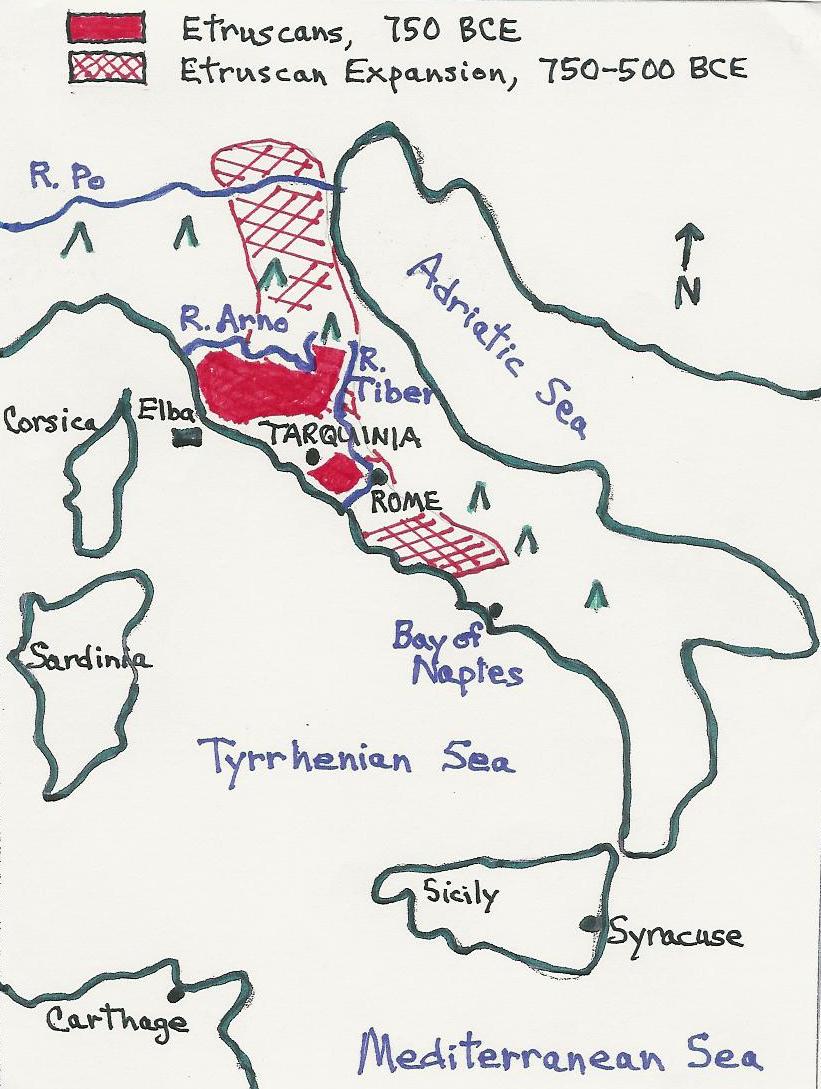|
|

Map of Etruscan Territory,
500 BC
Map of Etruscan Cities (wait for
pins to load).
|
Timeline |
| 1600 BC |
Etruscans emerge |
| 750-500 |
Expand into center of Italy and then to
north and south |
| 600-400 |
Glory Days: height of wealth and power |
| 500-100 |
Defeats by Greeks in S. Italy, by Romans in
center, and
by Gauls in the North. End of Etruscan
power and wealth. |
Etruscan Expansion: Color Codes
Pink:
original Etruscan
city-states, c 750 BC.
Blue:
expansion to the north,
700-600 BC
Yellow:
expansion to the south,
700-600 BC
Green:
Corsica, now part of France. |
|
Etruscan City-States
The Etruscans lived in a loose
group of hilltop settlements and other villages that shared a common language
that was not Latin. About 30 of varying sizes are known.
Twelve may have gathered together in a League of Etruscan
Cities. Which twelve is not all that clear.
In modern times, Rome in its early days is characterized as
"Etruscan" because a group of Etruscan kings may have ruled
there. Certainly they brought Etruscan engineering and artistry
to early Rome: the giant sewage system known as the Cloaca
Maxima, and a temple over 65 yards long on the top of the
Capitoline hill.
Etruscan cities show some measure of central urban planning.
Streets are laid out in north-south grid patterns. The Etruscans
built reliable water supplies and covered drains. Shrines and
temples would have been placed on a town's acropolis. Here the
influence of the Greek city ends: the Etruscans had no public
meeting place like a piazza or agora. They also had no
democracy.
An Etruscan "city-state" was not large, but it was more than a
village. It usually included
a hinterland of outlying peoples and villages in addition to its
urban nucleus.
-Some cities have completely vanished over time.
-Some can be located but are buried under the debris of the centuries.
-Others thrive today as modern Italian towns.
-Only a few of the surviving ancient sites have artifacts:
their tombs and town walls. Not easy to cart
these off to private collectors or to museums.
|
| |
| Name Today |
Roman/Etruscan Name |
Notes |
| Arezzo |
Arretium |
Known for its
bronze armament manufacturing and red clay pottery. |
| Cerveteri |
Caere |
Key city.
Today: Site worth a
visit |
| Chiusi |
Clusium |
5th c BCE
tomb remains. |
| Cortona |
Cortona |
A few artifacts
at Etruscan Museum and Archeological Park. |
| Fiesole |
Faesulae |
Remnants of
Etruscan walls |
| Orvieto or
Bolsena |
Volsinii,
Velzna |
Key city.
Headed Etruscan League in 5th c BCE. The National
Archeological Museum of Orvieto has an excellent English
web site:
Orvieto National Museum |
| Perugia |
Perusia |
The National
Archeological Museum of Perugia contains the Perugia
stone and tour itinerary. The Stone is one of the longest extant inscriptions in the
Etruscan language. Same Web site as above for Orvieto. |
| Populonia |
Populonia,
Pupluna, Fufluna |
The
only large Etruscan city directly on the sea. Center of
smelting of copper, silver, and iron ores from
the nearby island of Elba. First city in Etruria to coin
silver. |
| Tarquinia |
Tarquinii |
Key city.
Worth a visit.
Famous for beauty of its wall paintings in tombs. |
Vetulonia area
(incl. Roselle
Grosseto, Cosa) |
Vetulonia,Vatl |
A
few tombs, necropolis, park and a Museum.
|
|
Veii. Town abandoned; site remains. |
Veii |
Key city.
Worth a visit. Known
for terra cotta sculptures. Has the oldest painted Etruscan
tomb is in Veii, The Tomb of the Ducks, c 650
BCE. |
| Volci |
Vulci |
Key city.
Known for its art. Good Web site for its Museum and Archeological Park:
Volci Museum and Park |
| Adria |
Adria |
|
| Bologna |
Bononia |
|
| Cesena |
Caesena |
|
| Mantua |
Mantua |
|
| Marzabotto |
Misa |
|
| Modena |
Mutina |
|
| Parma |
Parma |
Piacenza Museum
|
| Ravenna |
Ravenna |
|
| Spina-abandoned |
Spina |
|
| Aleria |
Aleria |
|
| Capua |
Capua |
|
| Ischia |
Pitecusa |
|
| Nola |
Nola |
|
|
Pompeii-abandoned |
Pompeii |
|
| Rome |
Roma |
At
least three Kings of
Rome were Etruscan. The major Etruscan Museums are in
Rome. |
|
Suessula-abandoned |
Suessula |
|
| Tuscania |
Tuscana |
|
| |
|
|
| You may
contact me, Nancy Padgett, at
NJPadgett@gmail.com.
Updated 25 February 2016 |
|
|
|
|
|